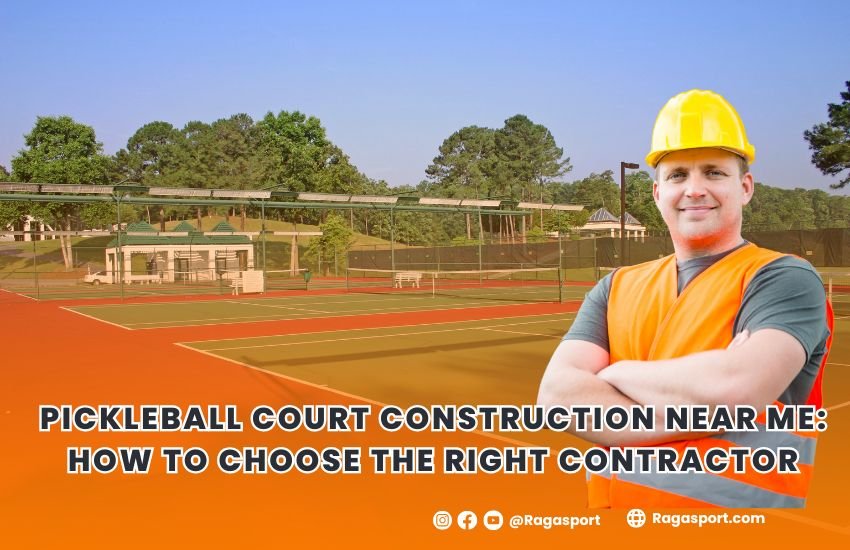The popularity of pickleball is growing rapidly across communities worldwide. From recreational players to competitive athletes, the demand for professionally built pickleball courts is on the rise. If you’re searching for “pickleball court construction near me,” choosing the right contractor is crucial to ensure quality, longevity, and compliance with standards.
Building a pickleball court requires more than just laying a surface. It involves technical planning, knowledge of materials, and adherence to sport-specific regulations. This guide explores what to look for when selecting a contractor and what to expect during the process.
Table of Contents
1. Understand the Basics of Pickleball Court Construction
Before hiring a contractor, it helps to understand what a standard pickleball court requires. The official court dimensions are 20 feet wide by 44 feet long for both singles and doubles. The total recommended play area, including out-of-bounds zones, is approximately 30 by 60 feet.
Key construction elements include:
- Site preparation and grading
- Sub-base compaction
- Surface materials (concrete or asphalt base)
- Surface coating with color and texture
- Court markings
- Net system installation
- Optional fencing and lighting
A reliable contractor must be familiar with these specifications and how to implement them in various site conditions.
2. Look for Specialized Experience
Not all paving or construction companies are qualified to build sports courts. A contractor with general concrete experience may not understand the specific requirements for pickleball.
Choose a contractor who specializes in sports facility construction or, more specifically, racquet sports courts. Ask for a portfolio of completed projects and client references. Contractors with proven experience will know how to:
- Optimize drainage and slope
- Prevent surface cracks
- Apply sport-grade coatings
- Install permanent net posts correctly
Experience with similar projects indicates the contractor can handle local conditions and tailor the court to your needs.
3. Assess Material Quality and Construction Standards
The longevity of your court depends heavily on materials and workmanship. High-quality surfaces reduce maintenance and provide consistent play. Substandard work leads to uneven bouncing, rapid wear, and safety hazards.
Ask prospective contractors about:
- The type and thickness of asphalt or concrete base
- The brand and type of acrylic coatings
- Cushioning systems (optional for premium courts)
- UV protection and anti-slip treatments
Also verify that the contractor complies with guidelines set by USA Pickleball or other recognized authorities.
4. Check for Customization Options
Each site is different, and your court should reflect your preferences and available space. A good contractor will offer tailored solutions including:
- Color schemes for surface coatings
- Multi-court layouts (if combining with tennis or basketball)
- Windscreens and lighting installation
- ADA accessibility considerations
Customization adds value and enhances usability. Avoid contractors who offer only one-size-fits-all packages.
5. Consider Indoor vs Outdoor Installations
Pickleball courts can be built indoors or outdoors. Outdoor courts need special attention to weather protection, drainage, and coatings that can handle sunlight and rain.
Indoor courts, on the other hand, must account for flooring material, ceiling height, lighting, and ventilation. Ask your contractor about their experience with both types of installations and their ability to adapt to the setting.
6. Evaluate Communication and Transparency

From the first consultation to project completion, clear communication is essential. A reliable contractor should provide:
- A detailed project proposal
- A transparent timeline and budget
- Regular progress updates
- Access to decision-makers throughout the process
If communication feels inconsistent or unclear during the planning phase, it may lead to larger issues during construction.
7. Request a Site Visit and Evaluation
An on-site evaluation is an important part of the process. A professional contractor should assess your location for:
- Space availability
- Grading and drainage needs
- Sun and wind exposure
- Accessibility for equipment
This visit allows them to tailor their proposal to real-world conditions and helps you get a realistic idea of what the finished court will look like.
8. Review Warranties and Maintenance Plans
Even the best-built court requires maintenance. Ask about warranties offered on surfacing, coatings, and net systems. A reliable contractor will also offer advice or services for routine maintenance such as:
- Surface cleaning
- Restriping
- Crack repair
- Recoating every few years
Long-term support is a sign of a contractor’s confidence in their work and commitment to customer satisfaction.
9. Compare Quotes and Value
Price should not be the only factor in your decision. Compare bids from at least three contractors, but evaluate them on the basis of:
- Experience and specialization
- Materials and equipment
- Timeline guarantees
- Past client reviews
A slightly higher quote from a specialized builder may save money long term through reduced repairs and better performance.
10. Ask for Licenses and Insurance
Verify that your contractor is fully licensed to operate in your region and carries liability insurance. This protects both parties in case of property damage or injury during the project.
Also inquire whether subcontractors will be involved and if they are similarly insured and experienced.

Ready to build a professional pickleball court that lasts?
Visit https://ragasport.com to explore expert pickleball court construction services tailored to your location.
📞 Contact us via WhatsApp at https://wa.me/6281335666607

